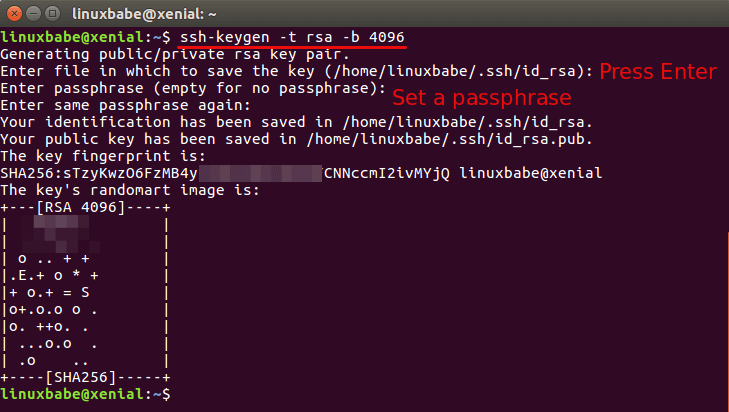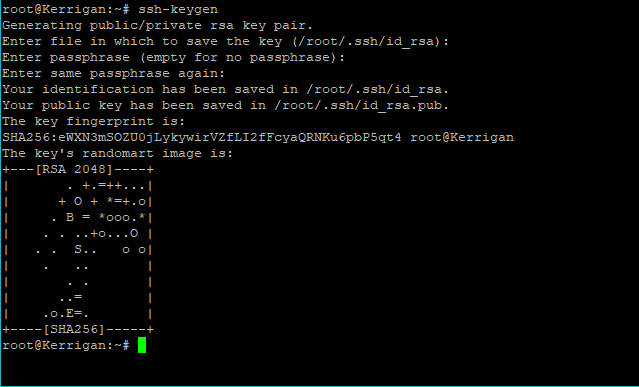Rhel Generate Ssh Key Pair
Sep 06, 2019 Generating a key pair and propagating the public key. Generating your key pair and propagating your public key is simpler than it sounds. Let’s walk through it. Generating the key. The minimum effort to generate a key pair involves running the ssh-keygen command, and choosing the defaults at all the prompts: $ ssh-keygen Generating public/private rsa key pair. Generate an RSA key pair using the ssh-keygen utility. Open a new command prompt and enter the following command: Open a new command prompt and enter the following command: ssh-keygen -t rsa.
Generating Your SSH Public Key Many Git servers authenticate using SSH public keys. In order to provide a public key, each user in your system must generate one if they don’t already have one. Nov 20, 2019 Generate Public Key. This method involves generating an SSH key pair on the source machine and place it on the destination machine by login into it manually. First, login into the source machine and create an SSH key pair using the following command. email protected $ ssh-keygen. Output: Generating public/private rsa key pair. I'm trying to create an ssh key for another user. If you generate the key for the user you also have to have a secure method of getting the private key and it's. Apr 12, 2018 Step 1 — Create the RSA Key Pair. The first step is to create a key pair on the client machine (usually your computer): ssh-keygen By default, ssh-keygen will create a 2048-bit RSA key pair, which is secure enough for most use cases (you may optionally pass in the -b 4096 flag to create a larger 4096-bit key).
 -->
-->With a secure shell (SSH) key pair, you can create virtual machines (VMs) in Azure that use SSH keys for authentication, eliminating the need for passwords to sign in. This article shows you how to quickly generate and use an SSH public-private key file pair for Linux VMs. You can complete these steps with the Azure Cloud Shell, a macOS or Linux host, the Windows Subsystem for Linux, and other tools that support OpenSSH.
Note
VMs created using SSH keys are by default configured with passwords disabled, which greatly increases the difficulty of brute-force guessing attacks.
For more background and examples, see Detailed steps to create SSH key pairs.
For additional ways to generate and use SSH keys on a Windows computer, see How to use SSH keys with Windows on Azure.
Supported SSH key formats
Azure currently supports SSH protocol 2 (SSH-2) RSA public-private key pairs with a minimum length of 2048 bits. Other key formats such as ED25519 and ECDSA are not supported.
Create an SSH key pair
Use the ssh-keygen command to generate SSH public and private key files. By default, these files are created in the ~/.ssh directory. You can specify a different location, and an optional password (passphrase) to access the private key file. If an SSH key pair with the same name exists in the given location, those files are overwritten.
The following command creates an SSH key pair using RSA encryption and a bit length of 4096:

If you use the Azure CLI to create your VM with the az vm create command, you can optionally generate SSH public and private key files using the --generate-ssh-keys option. The key files are stored in the ~/.ssh directory unless specified otherwise with the --ssh-dest-key-path option. The --generate-ssh-keys option will not overwrite existing key files, instead returning an error. In the following command, replace VMname and RGname with your own values:
Provide an SSH public key when deploying a VM
To create a Linux VM that uses SSH keys for authentication, specify your SSH public key when creating the VM using the Azure portal, Azure CLI, Azure Resource Manager templates, or other methods:
If you're not familiar with the format of an SSH public key, you can display your public key with the following cat command, replacing ~/.ssh/id_rsa.pub with the path and filename of your own public key file if needed:
A typical public key value looks like this example:
If you copy and paste the contents of the public key file to use in the Azure portal or a Resource Manager template, make sure you don't copy any trailing whitespace. To copy a public key in macOS, you can pipe the public key file to pbcopy. Similarly in Linux, you can pipe the public key file to programs such as xclip.
The public key that you place on your Linux VM in Azure is by default stored in ~/.ssh/id_rsa.pub, unless you specified a different location when you created the key pair. To use the Azure CLI 2.0 to create your VM with an existing public key, specify the value and optionally the location of this public key using the az vm create command with the --ssh-key-values option. In the following command, replace VMname, RGname, and keyFile with your own values:
If you want to use multiple SSH keys with your VM, you can enter them in a space-separated list, like this --ssh-key-values sshkey-desktop.pub sshkey-laptop.pub.
SSH into your VM
With the public key deployed on your Azure VM, and the private key on your local system, SSH into your VM using the IP address or DNS name of your VM. In the following command, replace azureuser and myvm.westus.cloudapp.azure.com with the administrator user name and the fully qualified domain name (or IP address):
If you specified a passphrase when you created your key pair, enter that passphrase when prompted during the login process. The VM is added to your ~/.ssh/known_hosts file, and you won't be asked to connect again until either the public key on your Azure VM changes or the server name is removed from ~/.ssh/known_hosts.
Rhel Generate Ssh Key Pair Number
If the VM is using the just-in-time access policy, you need to request access before you can connect to the VM. For more information about the just-in-time policy, see Manage virtual machine access using the just in time policy.
Rhel Generate Ssh Key Pair Authentication
Next steps
Generate Ssh Key Ubuntu
For more information on working with SSH key pairs, see Detailed steps to create and manage SSH key pairs.
Ssh keys download. Thus its use in general purpose applications may not yet be advisable.The algorithm is selected using the -t option and key size using the -b option. The following commands illustrate: ssh-keygen -t rsa -b 4096ssh-keygen -t dsassh-keygen -t ecdsa -b 521ssh-keygen -t ed25519 Specifying the File NameNormally, the tool prompts for the file in which to store the key.
If you have difficulties with SSH connections to Azure VMs, see Troubleshoot SSH connections to an Azure Linux VM.
You will know it is the serial number because it is amix of numbers and/or letters separated by dashes, usually 20characters long.You can't install this software without the serial number.Follow the on screen instructions during installation. One of theinstructions will come up asking you to enter the serial number -put it into the white boxes - and the installation will continue.You can't use the software without installing it.Contact costumer services at Supreme Commander's company bymail, email, or phone. The serial number would either be on the back of the CD case orwithin the documentation that came with your software when youpurchased it.
